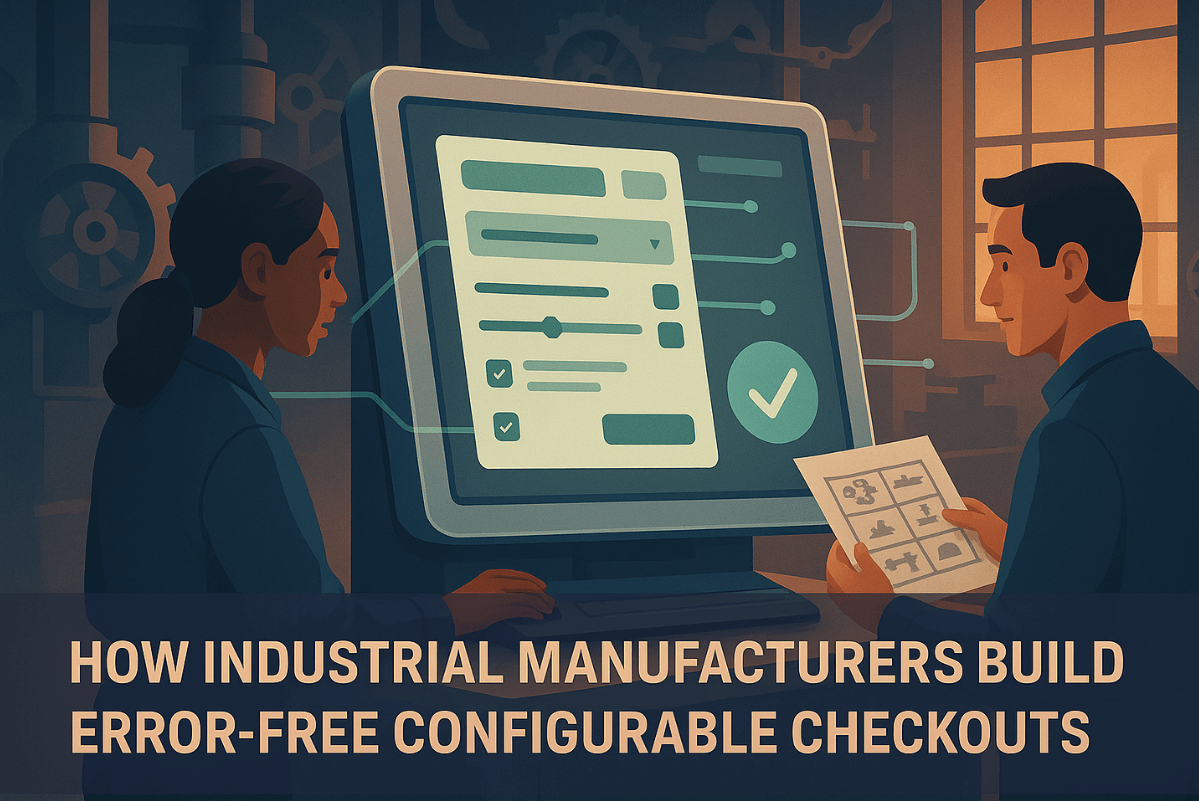Building an online store for configurable industrial products seems like a smart move, until the wrong order hits the production floor.
A customer selects the wrong voltage. The controller doesn’t match the actuator. A flange diameter is off by a few millimeters. Suddenly, what seemed like a simple online order turns into an expensive phone call, a refund, a back-and-forth with engineering, and a delay that frustrates everyone.
Most B2B ecommerce platforms weren’t built for this level of complexity. They’re optimized for clean, simple SKUs—T-shirts, tools, and coffee makers. Not multi-variable, highly engineered products where one wrong input breaks the whole system.
And yet, industrial manufacturers are under pressure to offer self-service buying. Distributors expect it. End-users demand it. But without proper validation, letting customers place orders on their own can feel like playing Russian roulette with your margins.
This article is about fixing that.
It’s about building an e-commerce experience that understands what you’re selling—and makes sure your customer orders it right the first time. Whether you sell air handling units, switchgear assemblies, precision valves, or anything else with cascading technical requirements, this is your roadmap to error-proof checkout.
Why Most Ecommerce Checkouts Break Under Technical Complexity
Standard e-commerce checkouts were built for selection, not validation.
They let you pick a size, color, and quantity. Maybe even customize a few add-ons. But they weren’t designed to understand engineering logic. There’s no room for rules like
- “If this product is 3-phase, then only show 480V or 600V options.”
- “Only allow this motor if the selected gear ratio is below 5:1.”
- “Disable option B if connector type X is chosen.”
You can slap a configurator on top of your product page, but most of those tools are cosmetic. They collect selections. They don’t validate them. And they definitely don’t understand the downstream effects of a bad combination.
What happens next?
A sales engineer has to manually check the order. Or worse, it slips through, gets built, and shipped wrong. Now you’re facing returns, field service calls, or even warranty claims, all because the e-commerce layer didn’t catch something a junior engineer would’ve flagged in two seconds.
These are not edge cases. They’re systemic. And for manufacturers selling complex, configurable products, they erode trust, margin, and scalability.
That’s why the solution isn’t “better configurators.” It’s intelligent validation systems, layered directly into the checkout experience.
Why Configurable Products Break Most Checkout Experiences
If you’ve ever tried to sell a product that comes in 12 different voltages, 6 flange types, 3 motor variations, and two dozen possible combinations of controller inputs,you already know the problem.
These products aren’t hard to configure because they’re exotic. They’re hard because everything depends on everything else.
Change one variable, and suddenly five other inputs become invalid. But the average e-commerce platform has no idea this is happening. It just collects dropdown selections and passes the data downstream, blind to whether it actually makes sense.
That’s where things start to unravel.
Most technical products aren’t modular in the clean way e-commerce systems want them to be. They’re full of dependency rules, many of which only exist in the minds of senior engineers or are buried in 200-page PDFs no customer reads.
Think about what this looks like in the real world:
- A customer orders a pressure regulator but picks a housing that can’t handle the selected PSI.
- They select a cable length that’s too short for the use case, but the system doesn’t flag it.
- They configure a control panel that technically fits their enclosure but can’t be certified for their region.
None of these are outrageous errors. They’re subtle. And that’s what makes them dangerous. Because these issues don’t show up at checkout, they show up when it’s too late.
The other problem? Your product experts aren’t scalable. You can’t expect your engineers to review every single online order. But that’s exactly what happens in most industrial e-commerce setups. The system takes the order, but the humans are still the gatekeepers.
That’s not digital transformation. That’s a bottleneck wrapped in a frontend.
To fix this, you need a system that doesn’t just take orders—it understands them. One that can read a customer’s selection, cross-check it against real engineering logic, and stop bad configurations before they happen.
That’s where validation-driven checkout comes in. And in the next section, we’ll look at the true cost of not having one.
The Real Cost of Letting Customers Order the Wrong Thing
If you’ve ever had to call a customer and tell them their $15,000 order can’t be built the way they submitted it, you already know: configuration errors are expensive—financially, operationally, and reputationally.
But the true cost goes deeper than just one bad order.
Time Is Burned on Manual Review
When your e-commerce platform doesn’t validate technical inputs, someone has to. That usually means pulling in a sales engineer or a product manager to cross-check every configuration before it hits production. Multiply that by dozens—or hundreds—of orders a month, and suddenly your technical team isn’t building. They’re babysitting.
That kind of overhead isn’t just inefficient. It stalls your ability to scale.
Manufacturing Slows to a Crawl
What happens when an invalid order slips through? The shop floor stops. Procurement has to scramble. Parts don’t fit. Timelines collapse. Everyone loses. And it’s not because the product was bad; it’s because the input rules weren’t enforced upstream.
Your plant shouldn’t be the first place where a configuration mistake gets caught. But without validation in the checkout process, that’s exactly what happens.
Returns Get Complicated—and Costly
Returning a shirt is one thing. Returning a pallet of misconfigured electrical panels? That’s a logistical and financial nightmare. Shipping, inspection, restocking, and rebuilding—each of those steps adds friction, cost, and margin erosion.
And worse, it makes your customers question your process:
“How did you even let me order this if it doesn’t work?”
Your Brand Takes a Hit
The worst part? You might never even hear the complaint. Some customers just stop buying. They don’t fight. They don’t ask for a fix. They just quietly move to a competitor who makes it easier to get it right.
All because your e-commerce experience asked them to make technical decisions it wasn’t equipped to validate.
This isn’t about blame. It’s about systems. And the truth is, every bad configuration is preventable if your checkout knows how to think like an engineer.
Why Standard Ecommerce Platforms Can’t Handle This
On the surface, platforms like Shopify, BigCommerce, or Magento seem like they should be able to handle configurable product sales. After all, they offer variants, product options, and even custom fields. But once you start layering in real technical complexity, think voltage compatibility, flow rate limitations, or interdependent parts, they begin to show their limits very quickly.
That’s because these platforms were built for retail. They’re optimized for simplicity, speed, and visual merchandising, not for engineering logic. Their systems treat every product like an SKU with a few dropdowns, not like a machine with a BOM behind it. The idea that one option should cancel out or unlock another isn’t something they’re designed to understand. If a customer selects a flange size that can’t support the chosen PSI or picks a power source that doesn’t match their controller, the platform won’t flag it. It will happily let the order go through, no questions asked.
This is where many manufacturers make an assumption: that a product configurator app or plugin can solve the problem. But most of those tools are just surface-level input collectors. They allow the customer to choose from options, yes—but they don’t validate whether those choices actually make sense together. They don’t enforce logic. They don’t think.
And when the checkout doesn’t think, the burden falls back on your team. Someone in sales or engineering ends up reviewing the order manually, catching the mistake, and calling the customer to revise it. In some organizations, this happens constantly, creating a silent drag on efficiency that feels normal only because it’s always been that way.
This isn’t e-commerce. It’s order collection with a safety net of humans behind the curtain. And while it may have worked when online ordering was a small part of your business, it’s a serious problem once you start scaling digital sales. The more orders you take, the more errors slip through or the more internal time gets wasted catching them.
Ultimately, standard e-commerce systems weren’t built to validate technical relationships between product attributes. They’re great for buying T-shirts or phone cases. But they have no business trying to manage something as complex as a modular pump system, a custom electrical panel, or an industrial assembly that has to meet safety and performance tolerances. Expecting them to do so is like expecting a vending machine to give you product advice—it might accept your order, but it has no idea if you made a mistake.
That’s why the real solution starts with rethinking the checkout itself. What if your e-commerce system didn’t just take orders but made sure every order was buildable, correct, and fully aligned with your internal specs?
That’s what a validation-driven checkout does. And we’ll break that down next.
What an Intelligent, Validation-Driven Checkout Looks Like
Imagine a customer landing on your site to order a complex product—say, a control panel with five optional modules, three voltage options, and specific environmental constraints. Now imagine that, instead of passively accepting whatever they select, your e-commerce system actively guides them through the process. It adapts in real time. It knows what combinations are valid. It doesn’t just take the order; it makes sure the order works.
That’s the difference with a validation-driven checkout.
At its core, this kind of system doesn’t treat each product option as an isolated choice. It recognizes relationships between inputs—technical, regulatory, and functional—and applies logic to ensure everything fits together. If a user selects a motor above a certain horsepower, it automatically adjusts the controller options to match. If a customer chooses a European plug type, it removes voltage settings that aren’t compliant. If an item exceeds the weight threshold for a mounting configuration, it alerts the buyer before they proceed. It behaves like a seasoned sales engineer sitting quietly in the background, nudging every decision toward a workable outcome.
But it’s not just about rules—it’s also about presentation. A validation-first system feels intuitive for the customer. They aren’t overwhelmed with every possible choice up front. Instead, the interface reacts to what they choose. Options appear or disappear. Input fields change dynamically. Tooltips offer explanations at just the right moment, clarifying why certain combinations are disabled. Rather than locking the customer into rigid preconfigured bundles, the system offers flexibility—with safety rails.
This kind of logic doesn’t live in a plugin or widget. It’s deeply integrated into the product architecture of your store, ideally drawing from the same source of truth your internal teams use: ERP systems, BOM databases, or engineering rule sets. That’s what gives it real authority. It’s not just guessing; it’s enforcing what your operation already knows to be true.
For customers, this creates confidence. They don’t have to second-guess whether they’re choosing the right flange, fitting, or actuator. They’re guided through a process that feels intelligent, helpful, and tailored. For your team, it means fewer order errors, less back-and-forth, and a smoother path from quote to production.
Most importantly, it removes the need for manual intervention. The checkout itself becomes a safeguard. When you get to that point, you don’t just have a better website; now you have a system that allows your business to scale without sacrificing accuracy.
Behind the Scenes: How the Logic Actually Works
To the customer, a validation-driven checkout feels seamless—options appear, others vanish, and everything just makes sense. But beneath that intuitive interface is a structured system of logic rules and conditional relationships that mimic the thinking of your best engineers.
At the core, it starts with if-this-then-that logic. This isn’t simple branching like “if the user selects Option A, show Option B.” It’s often multi-layered. For example, selecting a 230V power input might unlock or disable dozens of downstream choices—motor types, connector styles, certifications—all at once. The system needs to understand these dependencies, apply them instantly, and cascade those changes without freezing or confusing the user.
These rules are built on attribute mapping, where every product component or option has associated metadata—tolerances, capacities, compatible ranges, and application notes. The system doesn’t just look at product names or SKUs. It looks at attributes and validates compatibility in real-time based on those values.
In more advanced setups, the logic isn’t static. It can pull from live sources—like your ERP, your manufacturing database, or your warehouse management system. This means if a specific pump isn’t in stock, or if a flange has been deprecated in the latest engineering release, the checkout reflects that immediately. There’s no risk of selling what can’t be built.
And because this logic is built centrally, you’re not maintaining hundreds of “custom rules” for each product. Instead, you’re building a rule engine—a scalable library of relationships that can be applied across products, categories, or customer types. For example, a sales engineer could create one rule that governs all voltage limitations across your entire motor line. Or another that enforces certification requirements based on geography.
The goal here isn’t just technical accuracy. It’s speed and scalability. You’re building a system that catches errors before they happen, eliminates unnecessary back-and-forth, and empowers the buyer to configure with confidence—even if they aren’t a technical expert.
And when it’s done right? Your e-commerce platform starts doing the work your internal team used to do manually. It becomes a front-line filter, a product expert, and a gatekeeper for buildable configurations, all rolled into a single experience that doesn’t just collect orders… it improves them.
The Business Outcomes of Validation-Based Checkout
When a manufacturer builds a validation-first checkout system, the impact is immediate—and measurable. You’re not just improving a form or making the site more user-friendly. You’re transforming how your company sells, delivers, and scales.
The most obvious benefit is fewer order errors. When your system catches misconfigurations before they hit production, the costs associated with fixing those mistakes vanish. No more chasing customers down for corrections. No more rebuilding products or reshipping freight. What the customer orders is actually what gets built—and shipped.
That naturally leads to faster quote-to-cash cycles. You’re not stopping every order for a manual review. You’re not waiting for sales engineers to flag an issue and send three follow-up emails. The process moves on its own, from configuration to checkout to fulfillment—confidently and without delays.
And when customers start getting their orders right the first time, their trust in your brand grows. You become easier to buy from. They don’t worry about “double-checking” specs with support. They feel empowered. That confidence increases repeat orders, improves satisfaction, and often leads to fewer support tickets post-purchase.
Internally, the effect is just as powerful. Your sales team gets time back. Your engineers stay focused on design, not data correction. And leadership sees the real payoff: a scalable, accurate digital channel that doesn’t rely on human intervention to protect margins.
Returns decrease. Lead times shrink. Customer satisfaction climbs. And your e-commerce channel, often dismissed as a “nice to have” in B2B, suddenly becomes a true revenue driver.
And here’s the real kicker: you don’t need to overhaul your entire system to make this happen. You can implement validation logic gradually—starting with your most error-prone products or highest-value configurations. Each step reduces friction, improves outcomes, and moves you toward a more resilient sales model.
When You Should Consider Building a Validation-First Checkout
You don’t need to overhaul your entire e-commerce infrastructure to know something’s broken. Usually, the signs are already there—subtle at first, but consistent.
Maybe your sales team spends more time double-checking orders than actually selling. Or maybe you’ve lost deals because customers were forced to email you just to confirm basic configurations. Maybe you’re fielding too many returns. Maybe your engineering team is quietly frustrated, reviewing the same preventable errors again and again.
That’s the moment you know: your current checkout process isn’t just inefficient—it’s holding your business back.
If your products require more than two or three technical decisions from the buyer and those decisions can impact compatibility, performance, or compliance, then you’ve already outgrown a basic ecommerce model. The more variables you ask customers to choose from, the greater the risk that they’ll choose something that technically works on paper but fails in the field. That’s not just a bad experience. It’s a reputation risk.
You should also consider validation-first checkout if your team is manually reviewing every order before it’s approved. That’s a huge red flag. Not only is it inefficient, but it also signals that your e-commerce experience is passing responsibility back to your staff, exactly what digital transformation is supposed to solve.
Another signal: if your most experienced sales engineers are the only ones who can “sign off” on complex configurations, you’ve got institutional knowledge trapped in individual heads. That’s risky. And it’s not scalable. Intelligent validation logic lets you bake that knowledge directly into your customer-facing system, so accuracy doesn’t depend on who happens to be working that day.
Finally, if you’re planning to grow online sales in the next 6–12 months, a validation engine should be on your radar before you scale. Why? Because it’s much easier to build logic into a system early than to reverse-engineer it after you’ve already collected hundreds of error-prone orders.
The truth is, if you’re already asking whether this applies to you, it probably does.
Configurable Product Checkout Toolkit for Industrial Manufacturers
Why Most Checkouts Fail in Manufacturing
| Standard Checkout Does… | But Can’t Handle… |
| Dropdown selection for size, color, options | Engineering logic: voltage compatibility, PSI limits |
| Basic product bundling | Interdependent component relationships |
| Quantity, shipping, payment | BOM-level constraints, safety standards, certifications |
| Plugin configurator with UI customizations | Dynamic rules based on machine specs or geographic codes |
Your product doesn’t break when ordered. It breaks when the wrong inputs are accepted without validation.
Validation-Driven Checkout Checklist
Use this checklist to assess readiness for an intelligent configuration flow:
☐Can each option (voltage, flange, controller) be mapped to technical rules?
☐Do engineering constraints exist in structured form (docs, spreadsheets)?
☐Are these rules known by humans but not digitized?
☐Do you have any products where more than 1 configuration mistake has occurred?
☐Are sales engineers reviewing orders pre-production?
☐Is customer trust impacted by incorrect or delayed builds?
If you’ve checked 3 or more → You’re a candidate for validation-first checkout.
Configuration Rule Examples (Translate Your Knowledge)
| Rule Type | Example |
| Hard Constraint | If Voltage = 3-phase, show only 480V / 600V options |
| Incompatible Combination | Disable Motor X if Gear Ratio > 5:1 |
| Certification/Region Based | Show only CE-marked units if Shipping Country = EU |
| Dimensional Interference | Flange diameter > 100mm disables mounting config A |
| Capacity Mismatch | Pump Curve = Flow rate above 5GPM disables Controller Model Y |
| Stock-Aware | Remove Model Z if In Stock = 0 (ERP sync) |
Build these into a centralized rules engine, not product pages.
Technical Inputs to Track in Checkout (Data Foundation)
| Input Needed | Why It Matters |
| Product Attribute Mapping | Ties options to engineering data |
| Material Compatibility | Prevents mismatched casing, seal, PSI, and flow issues |
| Voltage/Power Requirements | Avoids regional compliance issues and controller mismatch |
| Certification Requirements | Prevents incorrect orders for regulated markets (UL, CE, ATEX) |
| Inventory Availability | Hides options not in stock or under long lead time |
Data doesn’t need to be perfect. It needs to be structured enough to act.
Phased Rollout Plan (Start Smart, Not Big)
| Phase | Focus |
| Phase 1: Prioritize | Top 5 error-prone configurable products |
| Phase 2: Structure | Build logic rules in spreadsheet or logic table |
| Phase 3: Integrate | Layer into platform (custom, Shopify Plus, Headless) |
| Phase 4: Monitor | Track early metrics, order accuracy, team load |
| Phase 5: Expand | Add categories, stock sync, certifications |
Accuracy Isn’t a Feature—It’s a Requirement
In industrial manufacturing, a wrong configuration isn’t just a minor mistake. It’s a delay. A cost. A reputation risk. Sometimes, it’s all three.
That’s why this conversation matters. Selling configurable products online isn’t just about offering convenience. It’s about making sure every order that hits your floor is buildable, correct, and profitable. Because if your e-commerce platform can’t validate technical inputs, it’s not helping you grow—it’s just shifting the burden from your customers to your engineers.
The reality is this: customers want to self-serve. They want the speed and freedom of e-commerce without the fear of making the wrong call. And the moment you offer them that level of confidence, where they can configure complex systems without second-guessing, you don’t just close the sale. You earn long-term trust.
So if you’re seeing friction in your current process—manual reviews, preventable errors, frustrated buyers—it’s time to rethink the system. Not by replacing everything, but by upgrading the way your store thinks.
You don’t need to be perfect on day one. But you do need to start building toward a checkout experience that validates, protects, and scales.
And if you’re ready to do that, if you want to build a smarter, validation-driven ecommerce experience tailored to how your products work—contact us.
We’ve built these systems for industrial manufacturers who sell the kind of products most platforms can’t handle. We know how to turn complexity into clarity, and we’ll help you build a checkout experience that works as hard as the products you sell.
Let’s make your system smart enough to do the job right—every time.












